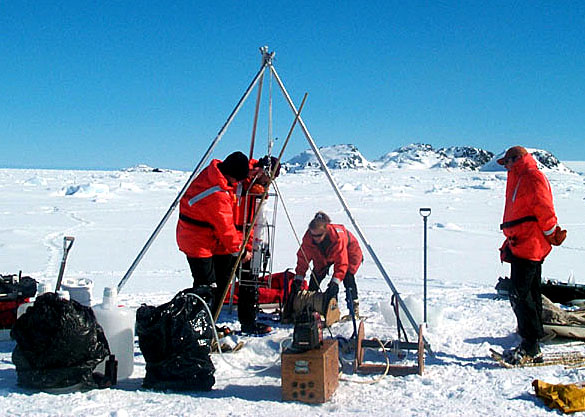|
Life in the cold and darkScientists head to Antarctica in winter to study small organisms with big ecosystem rolePosted April 11, 2008
Alison Murray studies tiny critters with a potentially big role in the marine ecosystem of the Southern Ocean surrounding Antarctica. Murray is interested in how bacterioplankton, the bacterial component of plankton communities, make their living in the Antarctic winter waters, when the long austral night presumably shuts down or slows many biological processes that rely on solar energy. Murray and her colleagues, who include several international collaborators, as well as Joe Grzymski, a colleague at the Desert Research Institute, and Hugh Ducklow, principal investigator for the Palmer Long Term Ecological Research (PAL LTER) program, will head to Palmer Station in July, the middle of winter. From the U.S. Antarctic Program (USAP) research station, they will collect and analyze the marine microorganisms, which also include a form of life distinct from bacteria called archaea. “The concept for the project is trying to understand what is unique about the organisms that are adapted to Antarctic winter,” explained Murray during a phone interview from her office at the Desert Research Institute in Reno, Nev. An International Polar Year (IPY) project, the study will focus on one of the key themes of the two-year-long polar science campaign: life in the cold and dark. Murray’s proposal dovetails nicely with a series of field projects she conducted earlier this decade from Palmer Station to characterize bacterial diversity and study their gene expression under a program focusing on extreme environments. Genetic expression studies what genes for an organism are “turned on” or “turned off” under different environmental conditions. Grzymski explained: “If an organism is really stressed out, it ‘turns on’ stress-response genes and ‘turns off’ genes that detract from the stress response. “Gene expression studies monitor what the cells are actually doing; it is one step beyond identifying the key players in the Antarctic winter and summer bacterioplankton communities,” he added. For example, organisms that live in ice and subzero temperatures might need to “turn on” genes that encode ice-binding proteins during a particularly low-temperature day in the sea ice, while simultaneously down-regulating, or “turning off,” genes involved in growth and metabolism to deal with the stresses due to ice crystal formation, which can break cell walls. The marine ecologists are particularly interested in figuring out how gene expression varies from season to season. From Murray’s previous work, they already know that composition and diversity of these microorganisms varies greatly from summer to winter. Murray said the question then becomes, “What is different between the organisms that dominate the plankton during austral winter and summer?” The answer lies in genome sequences of these organisms. Ducklow noted Murray’s previous work was instrumental in telling the researchers something about the composition of bacterial communities. It’s only in the last 10 years, he said, that researchers have been able to make such distinctions thanks to advances in molecular ecology and genomics, the study of genes that reveal biological diversity and the entire DNA sequence of an organism. “We just worked on ‘bacteria’ without any real attention to which ones were doing what,” explained Ducklow, a marine ecologist and co-director of The Ecosystems Center at the Marine Biological Laboratory in Woods Hole, Mass. “With new genomic tools, we can really probe the composition of that community.” Ducklow used the following analogy to explain the point further: Imagine walking in a forest. You see these things you know are trees, but you can’t tell one from the other — you can’t distinguish a pine tree from a birch, for example. “That’s the way we were with bacteria until quite recently,” Ducklow said. “So now we’re able to see what the changes are, and also be able to start investigating processes of how they’re able to change over the season and from place to place.” Murray helped solve that problem using a molecular biology tool called denaturing gradient gel electrophoresis. Basically, she developed a genetic barcode for the bacteria in the plankton community. Using samples collected over an entire year, her team was able to compare the genetic barcodes from summer and winter. “There is really large turnover,” Murray said of the seasonal comparison. “The barcode completely changed over that annual cycle, more so than anywhere else I’ve worked.” They also learned that bacterial diversity declines in summer, while the richest diversity occurs in winter. The finding is interesting because microorganisms are presumably more active in summer than winter, as they participate in various biological processes, such as the cycling of carbon and nitrogen. One might expect diversity to increase, not decrease, in the summer. “Maybe the summer conditions are a little rougher on the bacterioplankton than we previously acknowledged,” Murray said. “I think [increased winter diversity] is counterintuitive and something we’re looking into.” 1 2 Next |



For USAP Participants |
For The Public |
For Researchers and EducatorsContact UsU.S. National Science FoundationOffice of Polar Programs Geosciences Directorate 2415 Eisenhower Avenue, Suite W7100 Alexandria, VA 22314 Sign up for the NSF Office of Polar Programs newsletter and events. Feedback Form |


